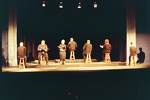|
Readers Theatre is a presentation style designed to explicate a text in such a way as to emphasize both character and narrative style. In terms of general presentation style, Readers Theatre is composed of several speakers, dressed in black, who present themselves in an array on stage from which they read the text. The presentation begins when the Theatre group walks onto the stage, sometimes silently, sometimes singing a song. Generally, main characters are seated at the front of the stage while narrators are standing, usually at podiums, behind. The readers read the text directly from black folders facing the audience. Characters up front are seated on a rotating chairs or stools. Generally the presentation starts with speakers up front with their backs to the audience (BTA), only turning around (TTA) to present that character's dialogue. If two characters are in conversation, both characters are facing forward but they look to the center back of the room, never directly looking at each other. If the character leaves a scene, she turns the chair away from the center of the stage to turn with her back to the audience. Narrators in the back generally stand very still until their portion is to be read, but they often mime certain actions while their character is speaking in order to empahaszie action or emotion. There is no overt acting, but hand motions are sometimes used, and voice and facial expression are very important In a nutshell, the text, unchanged in any way, is divided amongst speakers who embody the voices of not only the characters, but separate narrations that pertain to those characters. For example, in "Horton Hatches the Egg" by Dr. Seuss, the primary characters are Horton the Elephant and Maysie the Bird. Each one of these characters would be assigned a reader who would be responsible for their particular dialogue. In addition, each one of these characters would be assigned another reader who would express the thoughts, actions and other narrative surrounding these characters that did not include dialogue. Further, there is dialogue from Horton's friends, hunters who take him back to the city, circusgoers, and members of the circus. These different narrative voices must be identified, separated from one another and assigned a speaker. Theoretically, this means a presentation would have as many as seven different individuals. However, another element of Readers Theatre is, in the reading, the material is distributed amongst the readers is evenly as possible. In other words, a reader should not be on stage for long periods of time without some dialogue. That means minor characters might be assigned to one reader, and with voice changes by the reader, this can be quite effective. Readers Theatre is especially effective with children's literature, for it not only brings the work to life for the audience, but also children can easily be taught to present works in Readers Theatre Format. There are several benefits to this. One, the child begins to understand how dialogue works. Furthermore, understanding how narrative changes focus from one character to another through the process of having to decide what narrative goes with which character can help the student understand how the author changes focus and how work passes from one scene to the next. Readers Theatre is also very effective because it can bring drama and set the tone for material in a way that enhances the work. Generally, Readers Theater works are a literal reading of an original text. However, there is also original work created specifically for Readers Theatre, as well as hybridization of a published text with original material by the Readers Theatre author. If one intends to present Readers Theater to a large audience, generally it is a good idea to contact the author of the original work, especially if there's going to be a public presentation. Adams, William. Institute Book of Readers Theatre. San Diego: Institute for Readers Theatre, 2003. © T. T. Eiland, August, 2006 |
